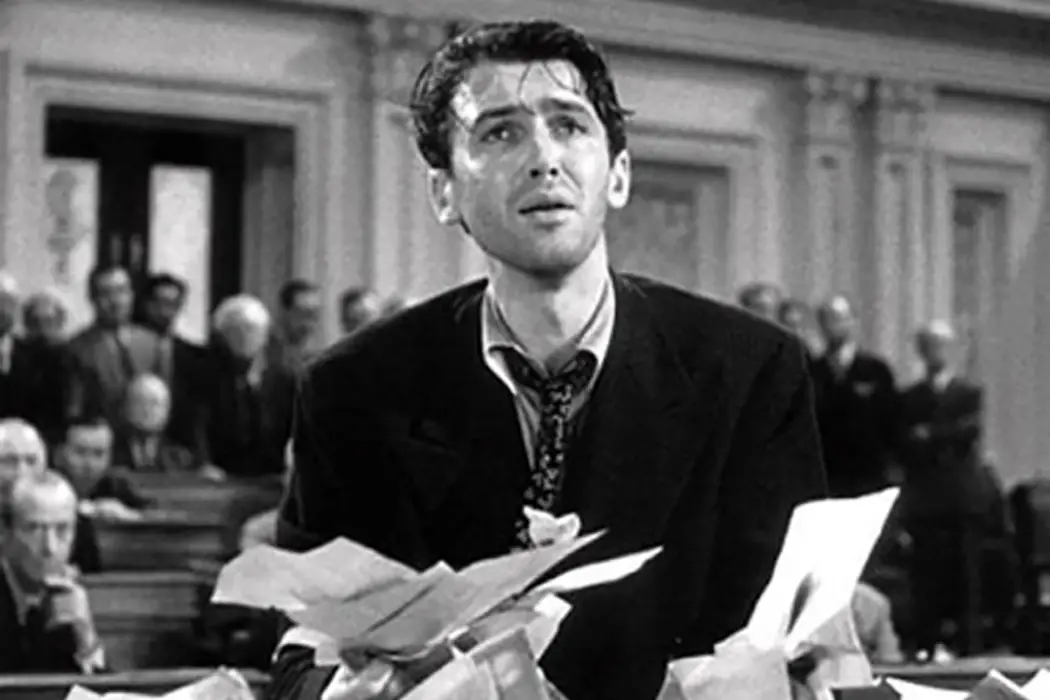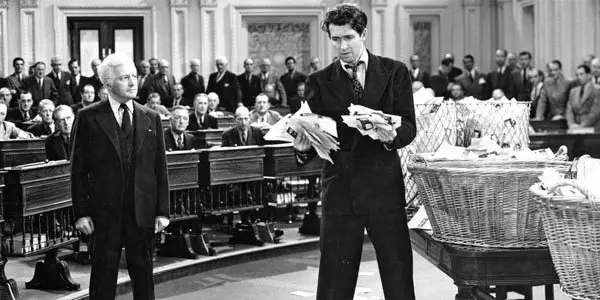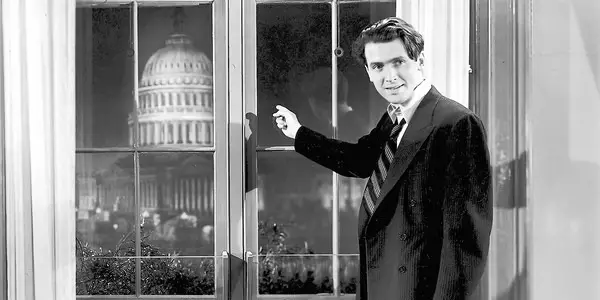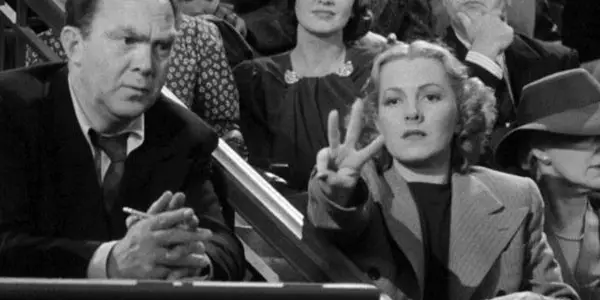The Nominated Film You May Have Missed: MR. SMITH GOES TO WASHINGTON

Stephanie Archer is 39 year old film fanatic living in…
Every year, ten movies are bestowed the honor of becoming nominated by the Academy of Motion Arts and Sciences. Many of these films will have already had various successes throughout the year – good festival attendance, box office success, and the receiving of other prestigious awards. Yet, only one of them ends the evening being declared the best of the best.
In 1940, the Academy held its 12th award ceremony – a ceremony where several of the Best Picture nominees are considered classics today and beloved treasures to be passed down to future generations. Gone with the Wind, The Wizard of Oz, and Wuthering Heights were some of the films honored with a nomination, and are shining examples of the film quality and movie brilliance of the time.
More commonly unknown by the masses, Frank Capra‘s Mr. Smith Goes to Washington was also a strong standing contender for Best Picture in 1940. While this film did not push the boundaries of filmmaking like some of its competitors, it did push the boundaries of storytelling through character development and a witty screenplay.
Yet, it is not only the characters and a witty script that make this film notable. Mr. Smith Goes to Washington is a timeless representation of a country’s mindset at a time when the world was quickly falling into darkness. While the United States had not yet joined World War II, the film shows an unmistakable push of democracy and patriotism within Hollywood and the country.
The Plot
Following the untimely death of their state senator, the governor of an undisclosed western state is left with the assignment of appointing a new one. Pressured by Jim Taylor, the local puppeteer of the state’s politics, Governor Hopper is resigned to do as he is told and appoint the individual of Taylor’s choosing. Yet, when the local committees and citizens of the state appoint their own nomination, he finds himself caught between a rock and a hard place. Believing the people’s choice to be ignorant and easily persuaded, he appoints Jefferson Smith to the state Senate against his puppeteer’s wishes.
Enlisted to mentor the new senator, as well as keep him in line, Senator Paine directs Mr. Smith to draft his own bill to create a Boys Club of America – a bill that inadvertently endangers a well-crafted graft he and Jim Taylor have been trying to quietly pass through the Senate. When Mr. Smith refuses to back down and threatens to expose the corruption these two men have brought to the Senate, he is quickly discredited and shamed.
With the help of his smart-mouthed and smart-minded receptionist, Mr. Smith embarks on a final attempt to save himself and the values of the country he holds so dear.
Character Development & Transitions
One of the strongest elements of storytelling within Mr. Smith Goes to Washington is the beautiful character development, and the transitions that they experience throughout the film. This can be seen strongly through the characters of Jefferson Smith, Saunders and Senator Paine. It is through these characters that the strength of Mr. Smith Goes to Washington shines through.
Jefferson Smith (played by James Stewart) arrives in Washington, doe-eyed and in sheer wonderment of the history that surrounds him and the democratic process he is about to be fully immersed within – ignorant to the corruption he will soon battle. He is the local joke, as he continues to exhibit his lack of decorum expected of a US Senator, and his inexperience continues to mar his time in office. It isn’t until Smith is tasked with creating his own bill that the true strength and perseverance of his character begins to break free. No matter how hard his assistant Saunders (played by Jean Arthur) tries to dissuade him from making this bill, he pushes on undeterred from the painstaking process he is about to undergo.

Through the drafting of his bill, Smith learns his mentor is part of a graft to benefit Jim Taylor (played by Edward Arnold). He is enraged and in disbelief of the depravity around him, swearing to fight it and bring it to light among the Senate. In doing so, Senator Paine (played by Claude Rains) accuses Mr. Smith of fraud and of grafting the bill for his individual benefit. With the Senate, Washington, and even his own state against him, Mr. Smith makes a last attempt for justice by holding a 24-hour filibuster in the Senate, yielding to no one until the truth has a chance to finally be heard. It is at this point his character has fully transitioned from a boy-minded individual into a strong, well-rounded man. He is no longer disillusioned, finally able to see not only the corruption, but that he, as one individual, has a chance to make a difference – and to be heard.
Saunders, the receptionist for Mr. Smith, is the film’s representation of the continuing movement of feminism within America. Her character is strong-minded and strong-willed – and she isn’t afraid to show it. Several times throughout the film, she expresses that she is degraded by being in the career she is in. On numerous occasions, she tells her reporter friend Diz (played by Thomas Mitchell) that she “wasn’t given a brain to tell a boy ranger what to do” and threatens to storm into Senator Paine’s office to hand in her resignation.
The character of Saunders does transition throughout Mr. Smith Goes to Washington, breaking down the walls she has built up around herself. At the beginning, she has little care for the history and the people surrounding her. Yet, as she finds herself spending more time with Mr. Smith, she begins to allow her sense of worth and patriotism to evolve. She finds the strength to finally quit her job, refusing to take part in destroying a man, and allowing herself the true opportunity to utilize all the knowledge she possesses for the greater good.
Senator Paine is brought face-to-face with moral conscience early in Mr. Smith Goes to Washington, while on the train with Jefferson Smith en route to Washington. They talk of how he used to be a champion of lost causes alongside Smith’s father. This is the first moment in the film when Senator Paine, quietly using his political power to graft a deal for Jim Taylor, is forced to look at the corruption he brings to the country and the Senate. Yet, this moral conscience is quickly thrown to the wayside as he finds that his task, as well as saving his skin, matter more to him than doing what is right.
While Senator Paine’s character transition is slow and subtle, it makes for an explosive change later on in Mr. Smith Goes to Washington. As he begins to battle against Mr. Smith to save himself and his deal for Taylor, viewers begins to see his strength and resilience begin to break down as his moral conscience starts to take hold. With his composure wavering, he fights until the final moment, when he can no longer see that the ends justify the means.
The Parallelism of Lincoln And Jefferson
Several times throughout the film, Jefferson Smith is referred to as Honest Abe. While other historical and literary references are used to reference our main character, this particular nickname held the most true and most relevant.
Abraham Lincoln was the 16th president of the United States. He was known as never telling a lie, and more importantly, as the man who stood up against a nation to fight for the injustice that was slavery. While liberating the slaves of the south was high on his political agenda, and remains his standing legacy, most of the country and fellow government officials were against him. He was a single voice against a strong organization fighting for what seemed like a lost cause. He dedicated his entire political term, and his life, to fighting for what he believed.

There is a parallelism that can be drawn between this great president and the main character of Mr. Smith Goes to Washington. Jefferson Smith, while on a smaller scale, is faced with what he sees as an injustice. He is fueled by his honesty and love for the values his country was built upon. Discredited and shamed in the Senate, he alone must stand against the corruption and rise up for a seemingly lost cause against the strong organization that opposes him. Like Lincoln, he shows that one voice can overcome a strong organization and be heard above the masses.
Corruption Of A Country
No matter what country or government you want to examine, corruption can be found even in what is seemingly the best. Corruption in politics is heavily examined within Mr. Smith Goes to Washington. Early on, viewers are shown that there are puppeteers behind the scenes influencing political officials for their own benefit – and that those who refuse to fall in line are subject to lose their power in an instant.
Corruption is also examined in this film as a means to justify an end. When confronted by Mr. Smith in regards to the graft, Senator Paine explains that he too was faced with the true nature of corruption and deciding what side he would fight for. He explains that while he does participate in it, one act of corruption can be excused because of the thousand acts of good that it allows him to do. The ends justify the means.
Yet, it is not only the corruption within politics that is represented within this film. Viewers are forced to look at the corruption in the news and media that they instill their trust in. A news interview with Mr. Smith is manipulated to make him look further inexperienced and a joke within the Senate, causing him to call out the media reporters to “tell the truth once in awhile.”
When Mr. Smith’s filibuster begins, several news reporters begin to report how the discredited Senator has taken over the Senate – several news agencies within his town inaccurately reporting, or being muscled into reporting, the story that Senator Paine and Taylor have fabricated. They are not bound to the same fact-checking as the politicians they report on – they don’t need to worry about reelection.
The Core Of Democracy: One VS The Many
Democracy in its simplest foundation is that through this form of government, the voice of the people can be heard. Even the voice of a single individual against the thunderous voice of the masses, or an organization, can change the nation and bring success to seemingly lost causes. This has been seen multiple times throughout this country’s history. The fight for independence and freedom, the fight against the injustices of slavery, and the fights for various civil rights through the years are only a few examples of how the voice of one can be heard over the voice of many.
The entire film builds itself to the epic moment when Mr. Smith must follow in the footsteps of his predecessors and be a voice for an injustice. He is faced with corruption and fights against a strong opposition too, once again proving that the basic foundations of Democracy hold true.
The American Propaganda
From the moment Jefferson Smith arrives in Washington D.C., Mr. Smith Goes to Washington is inundated with music and images representing America and the patriotism of the country. As Mr. Smith races around Washington taking in every patriotic representation it has to offer, his looks of wonderment are mimicked by those around him taking in the same views.

At this time in history, World War II had begun, with the Nazi agenda beginning to plague the world. While the United States had not joined the War yet, this film can clearly be seem as a reminder to the American people about the foundations that this country was built upon. It reinforces the ideal of patriotism and that, while corruption and oppression have occurred throughout time, the American people have always rose above and conquered.
Conclusion
While this film was released in a year that brought us some of the most known classics of film, Mr. Smith Goes to Washington was a nominated film of 1940 that stood strong against its competition. With strong character development and a hard look at political corruption, this film became a timeless classic.
Further examination of it shows that Mr. Smith Goes to Washington is a film of propaganda spurring out of a time of closing darkness, and from a country whose political basis spawns from the voice of its people. It is a film that, when watched time after time, viewers will see new aspects of it they had not considered before, and will also fall further in love with everything it has to offer.
Have you see Mr. Smith Goes to Washington? Tell us what you thought in the comments below!
Does content like this matter to you?
Become a Member and support film journalism. Unlock access to all of Film Inquiry`s great articles. Join a community of like-minded readers who are passionate about cinema - get access to our private members Network, give back to independent filmmakers, and more.













